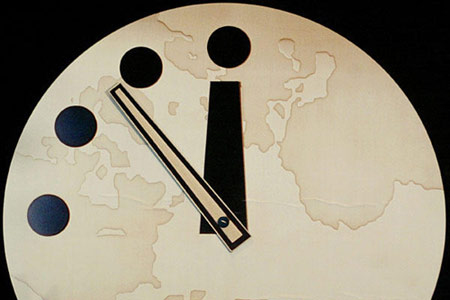當前位置: Language Tips> 雙語新聞
分享到
|
 Scientists on Tuesday pushed the hands of the infamous "Doomsday Clock" forward one minute from last year, signalling their increasing pessimism about the efforts of world leaders to handle global threats. |
|
Scientists on Tuesday pushed the hands of the infamous "Doomsday Clock" forward one minute from last year, signalling their increasing pessimism about the efforts of world leaders to handle global threats. "It is now five minutes to midnight," the Bulletin of the Atomic Scientists (BAS) said in a sober assessment of current trends. "Two years ago, it appeared that world leaders might address the truly global threats that we face. In many cases, that trend has not continued or been reversed." In January 2010, the clock's minute hand was pushed back one minute from five to six minutes before midnight. Midnight symbolizes humanity's destruction. The clock setting, which has been a staple since 1947, represents the severity of the perceived threat to humanity from nuclear or biological weapons, climate change and other human-caused disasters. When it began this annual tradition, the BAS set the time at seven minutes to midnight. Following the first test of the hydrogen bomb, the doomsday clock ticked to two minutes before midnight in 1953. When the United States and Russia began reducing their nuclear arsenals in 1991, the Bulletin set the clock at 17 minutes to midnight. In explaining its latest move, the BAS bemoaned the ability of global leaders to move ahead on ridding the world of nuclear weapons. There are about 19,500 nuclear weapons in the world today, according to the BAS, which cautioned that "it is still possible for radical groups to acquire and use highly enriched uranium and plutonium to wreak havoc in nuclear attacks." It also referenced last year's accident at Japan's Fukushima nuclear facility, saying the disaster underscored the urgency of developing safer nuclear reactor designs as well as better oversight, training, and attention. The gloom did not end there. The Bulletin believes that the world may have neared what it called "a point of no return in efforts to prevent catastrophe from changes in Earth's atmosphere." It said that in the absence of finding alternatives to carbon-emitting energy technologies within five years," the world will be doomed to a warmer climate, harsher weather, droughts, famine, water scarcity, rising sea levels, loss of island nations, and increasing ocean acidification. "Unfortunately, Einstein's statement in 1946 that 'everything has changed, save the way we think,' remains true," said BAS co-chair Lawrence Krauss. "The provisional developments of 2 years ago have not been sustained, and it makes sense to move the clock closer to midnight, back to the value it had in 2007." (Read by Emily Cheng. Emily Cheng is a journalist at the China Daily Website.) (Agencies) |
周二,科學家們把邪惡的“末日之鐘”的指針撥快了一分鐘,相對于去年更加逼近“末日” ,表示他們對于世界領袖應對全球威脅的行動感到越來越悲觀。 《原子科學家公報》冷靜地分析了現在的趨勢,指出:“現在是午夜11時55分,兩年前世界領袖們看上去好像真的能解決我們面臨的全球威脅。但是很多情況下,這一樂觀的趨勢并未持續或者說已經逆轉。” 2010年1月,“末日之鐘”的分針從11時55分調回11時54分。午夜零時象征著人類的毀滅。 “末日之鐘”于1947年設立,代表了人類感受到的來自核武器或生化武器、氣候變化及其它人為災難等威脅的嚴峻程度。《原子科學家公報》雜志每年都有調整“末日之鐘”的慣例, “末日之鐘”最初設定在午夜11時53分。美國1953年試爆第一顆氫彈后,“末日之鐘”調整至晚11時58分。美俄于1991年開始減少核軍火庫規模之后,“末日之鐘”又調整到11時43分。 對于這次最新的調整,《原子科學家公報》解釋稱,他們為全球領袖未能在清除核武器方面取得進展而感到惋惜。 據《原子科學家公報》報道,現在全球有一萬九千五百個核武器,并警告說“激進分子仍有可能獲得并且使用高濃縮鈾和钚來發動核襲擊造成嚴重破壞”。 該雜志還提到了去年在日本福島核電站發生的核泄漏事件,認為這次災難凸顯了設計開發更安全的核反應堆、加強監督、培訓和提高關注度的緊迫性。 災難帶來的陰霾并不止于此。公報稱世界或許已經接近了“地球氣候變暖引發大災難的不可逆轉之點”。“如果五年之內找不到碳排放能源技術的替代方法”,世界注定會出現氣候變暖、極端天氣、干旱、饑荒、缺水、海平面上升、島國消失和海洋日趨酸化。 《原子科學家公報》副主席勞倫斯?克勞斯說:“不幸的是,愛因斯坦在1946年所說的‘一切都已改變,除了我們的思維方式’依然正確。兩年前的短暫發展沒有延續,所以把‘末日之鐘’調回2007年更接近午夜的時間是合理的。” 相關閱讀 (中國日報網英語點津 實習生蔡冬梅 編輯:陳丹妮) |
|
Vocabulary: infamous: 聲名狼藉的;罪大惡極的 staple: 經常性內容 arsenals: 軍械庫;兵工廠 rid...of: 從……清除 wreak: 造成(破壞)等 havoc: 大破壞,浩劫 reference: 提及 oversight: 監督;照管 save: 除了 provisional: 臨時的,暫時性的 |
上一篇 : 紐約乘地鐵需小心 一人占多位或被捕
下一篇 : 美國國債超GDP 議員稱像看恐怖電影
分享到
電話:8610-84883645
傳真:8610-84883500
Email: languagetips@chinadaily.com.cn